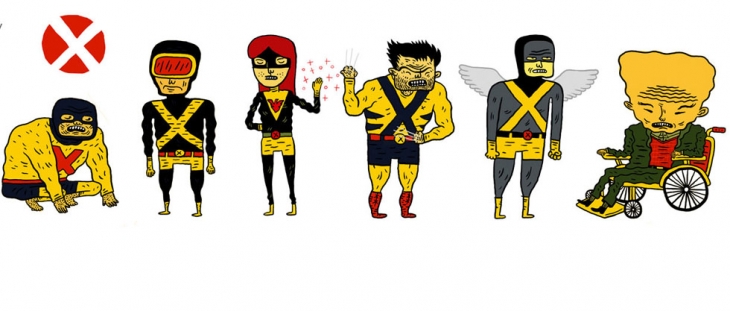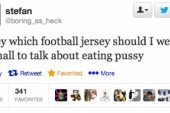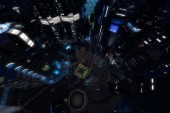
In the new issue of Lose, his annual-ish comics series, Michael DeForge claims to be “founder of Lulu.com” and “winner of the 1998 James Beard Award (Great Lakes Chef).” These are jokes/lies, but they’re almost plausible: his output is already legendary even by the precocious standards of a medium known for teenage prodigies. The cartoonist hardly seems to put down his pen, drawing self-published minicomics, contributions to myriad anthologies or magazines and freelance illustrations (his main source of income right now) at an epidemic pace. His creepily cute aesthetic and precise line were already evident in 2009’s Lose #1, published when DeForge was only 21. The main story follows Nesbit Lemon, a teardrop-shaped sprite consigned to the underworld after failing to talk a cartoonist named Michael DeForge out of suicide. He ends up at a hellish bar populated by famous, fading cartoon characters. So far, so meta, but DeForge pushes the conceit to disturbing extremes: as one desiccated mascot tells Nesbit, “your eyes can only pop out of their sockets so many times before the skin around them starts to sag.” Though stylized nightmares pervade DeForge’s comics, they’re often played for uncomfortable laughter. In the minicomic Peter’s Muscle, Peter Parker becomes obsessively Freudian after Doctor Octopus starts dating his Aunt May (this was an actual Spider-Man storyline back in the day). When DeForge displaces his painfully recognizable dialogue from its original social context, the satire becomes paradoxically sharper. Canine college students say things like “Lately I don’t know if I even enjoy walks,” while a hapless divorced dad in a post-apocalyptic wasteland informs his co-workers: “I’m gonna start seeing a therapist this week. I’m doing it partially as research for my screenplay!” The artist/critic Frank Santoro has described this magpie cartooning – agglomerating influences and tropes from alternative comics, genre comics, manga, animation, whatever – as “fusion comics.” It’s a omnivorous approach that DeForge clearly shares with younger peers like James Stokoe, Brandon Graham and Katie Skelly, though they don’t all work at such a frenetic pace. He’s not just launching Lose #3 at the upcoming Toronto Comic Arts Festival (May 8-9): TCAF will also see the debut of Thickness, a porn anthology co-edited with Ryan Sands (following their earlier Lady Gaga anthology Prison for Bitches), and, if DeForge can crank it out in time, the first issue of a whole new series called Open Country. The guy is scary. Oh, and did we mention he won the Best Emerging Artist award at last year’s TCAF? Can you tell me a bit about your background? When did you start reading comics, and when did you begin drawing them? I think I’ve always been reading comics, since I was little. I used to really like Calvin & Hobbes and Bloom County and Peanuts collections that my mom would have lying around the house. My dad used to read superhero comics, so that would be lying around the house also. You grew up in Ottawa, right? I think I read that you started out by drawing concert posters? Yeah, I was in Ottawa. I was drawing before then, but I started doing gig posters in high school because I didn’t have much money, and I didn’t have a fake ID, and that’s an easy way for promoters to put me on the list and get me into clubs. That’s when I started pursuing illustration more seriously. What’s your artistic process like? Are there certain pens or computer programs you keep using again and again? It’s usually both. Lately for comics I’ve been doing a lot of my inking digitally after scanning the pencils, but it depends on the project. It’s usually both, if it going to be for printed work. Even if most of it is inked by hand I’ll spend a lot of time cleaning it up on the computer. I interviewed Daniel Clowes last year, and one of the things we talked about was how the classic format of the alternative comics pamphlet seemed to be disappearing in favour of graphic novels or online serialization – but not entirely. You’re doing Lose, James Stokoe has Orc Stain, and there’s even going to be a new issue of Optic Nerve this year. As a younger cartoonist who still publishes a lot of work online, what is it about the alt-comics floppy that appeals to you? The reason I use it is because it happens to fit the length of stories I want to tell. None of those issues would really work if I tried to make them into a graphic novel. They don’t quite fit the minicomic form, and they weren’t drawn to be presented on the web. So that just happens to be a convenient form for me. And the reason it appeals to me as a reader is that I prefer getting art in small quantities, and [pamphlets] are pretty ideal for that. When I was growing up it was my introduction to a lot of these cartoonists – I wasn’t introduced to Adrian Tomine, for instance, through a collected form. It was through taking a chance on one of the stray Optic Nerve issues, and the same with Dave Cooper – I wasn’t buying collections of his work, it was more like taking a chance on Weasel. Horror is a difficult effect to bring off in comics, because it’s a static medium. How do you try to counteract or work around that? I try not to be too concerned about how much my work actually reads as a horror comic. Lose #2 is maybe more actually trying to be like a genre comic, but in general I find it’s best not to think about how scary it might read as. In a static comic, you can’t get any jump scares, but that’s the only limitation it has, and I think the still image has an advantage over a moving image in that – I’ve lingered over [Japanese manga artist] Junji Ito panels a lot longer than a scene from a movie has ever stayed with me, or specific panels from [Charles Burns’] Black Hole. Hideshi Hino comics. Those lingering still images have a power and value that’s hard to achieve in moving images. I read an interview with you that Matt Seneca did recently, and I liked the line about how, for you, horror might be described as “characters swept up in terrible events beyond their control.” It made me think that in strips like “Dog 2070” or Peter’s Muscle, most of the humour is created by the characters’ awkward social failures. Do you feel like that’s an integral element of comedy in general? I do. That is usually the source of conflict in most of the things I draw. I try to give all the characters pretty grounded anxieties despite the settings not necessarily being very grounded. You’re uncomfortably great at capturing/mocking the way a lot of people our age talk (Ed: early 20s!) – I’m thinking of those “Dogs in College” who won’t shut up about The Wire, or the guy writing home from a dystopian wasteland about his awesome internship. Do you end up revising dialogue a lot, or testing the way it sounds out loud? I’ll usually write snippets of things down for future use, yeah, things that I think are funny. And most of my dialogue – I make fun of it, but it comes from the way that me and most of my friends talk. I try to make fun of the fact that we all sound pretty stupid most of the time, that’s usually where I get the dialogue from. Like, that intern strip – my internship wasn’t that bad, but I had an internship [at Vice] and had misconceptions about it. What do you think about the whole concept of “fusion comics,” to use the term that Frank Santoro coined? It reminds me of this idea in music criticism at the end of the ‘90s and early 2000s, “poptimism,” not discounting things because they’re popular or genre-based. I think it is an appropriate way to describe some of the comics that I make and some of the other comics happening right now. Someone like Katie Skelly fits into that fusion comics category, but I don’t think any of us are thinking “I am gonna make a fusion comic” when we start out. It’s a term that makes sense but it’s not something that I’m super-aware of when actually working. What kind of influences have you had from outside of comics? I was thinking of David Cronenberg, because of Toronto and the whole body-horror thing, but I don’t know if you are actually a fan of his at all. I like Cronenberg, but I don’t think he’s a particular influence on me. Outside of comics, I really like Seripop a lot. They were very important to me. Eduardo Munoz Bachs, this poster artist and children’s illustrator. Mary Blair, the children’s illustrator… As far as movies go, Samuel Fuller? It’s hard to say what movies end up influencing me. The extreme conceptualism of Spotting Deer [which takes the form of a reference text on that made-up animal] made me wonder: Have you ever heard of the Oulipo? I don’t think so…oh wait, no, aren’t they those experimental French dudes? Yeah. Its name is abbreviated French for “workshop of potential literature,” and they try to work under constrained writing, like composing an entire novel without the letter E, or using mathematical formulae when writing. I just thought of them because one of the American members, this writer named Harry Mathews, who’s great, he famously wrote a short story in the form of a recipe. I didn’t feel like there was a lot of constraints with Spotting Deer. I probably approached it in a different way than trying to set up a bunch of restrictions. The idea of writing it all as a reference thing was actually kind of easier and more freeing than pacing out a regular comic, because it was more like just illustrating stuff a lot of the time, I didn’t have to pace things or put a lot of thought into storytelling. It was more like a good vehicle for a bunch of jokes.























